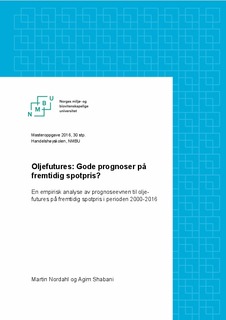| dc.contributor.advisor | Ole, Gjølberg | |
| dc.contributor.advisor | Steen, Marie | |
| dc.contributor.author | Nordahl, Martin | |
| dc.contributor.author | Shabani, Agim | |
| dc.date.accessioned | 2016-11-21T14:43:45Z | |
| dc.date.available | 2016-11-21T14:43:45Z | |
| dc.date.issued | 2016-11-21 | |
| dc.identifier.uri | http://hdl.handle.net/11250/2422222 | |
| dc.description.abstract | I denne masterutredningen undersøker vi om det er mulig å predikere fremtidige spotpriser på oljeproduktene WTI, Brent, Heating Oil og RBOB Gasoline ved bruk av futurespriser, samt lager- og posisjonsdata. I tillegg tester vi om futuresprisene er forventningsrette, og med det om markedene er effisiente. Ved bruk av månedlige observasjoner i en periode fra 2000-2016 har vi sett på prediksjoner med horisonter på 1, 3, 6 og 9 måneder. Vi har benyttet oss av in-sample og out-of-sample analyser for å teste futuresprisenes prognoseegenskaper. In-sample analysen består av 8 prediksjonsmodeller, mens i out-of-sample analysen sammenligner vi futuresprisen, spotprisen og basis som prognose.
Oppgaven starter med en innledning før vi går igjennom tidligere litteratur på temaet om prognostisering av råvarepriser. Videre tar vi en titt på den historiske prisutviklingen og risikoen i markedene vi skal undersøke. Deretter skal vi gjennomgå teori i form av to kjente modeller for prising av futureskontrakter på råvarer: lager- og risikopremieteorien. Så skal vi ta for oss dataene og metodene vi har anvendt før vi til slutt presenterer resultatene og analysene.
Resultatene viser indikasjoner på at futuresprisene til WTI og Brent er forventningsrette predikatorer av etterfølgende spotpris. Det kan tyde på at futuresprisen har vært en grei føring på fremtidig spotpris. Futuresprisene til Heating Oil og RBOB Gasoline viser mer tegn til å være skjeve predikatorer. Markedet for RBOB Gasoline er mindre modent og tidsserien er kortere, noe som kan være grunnen til at resultatene tyder i retning av at futuresprisen ikke er forventningsrett. I perioden 2005-2010, som inkluderer finanskrisen, gir resultatene antydninger til at markedene for de fire oljeproduktene kan ha vært ikke-effisiente. Resultatene ga derimot nokså tydelige indikasjoner på at lager- og posisjonsdata ikke forbedret futuresprisen som prognose, og at de ikke kan brukes til å predikere fremtidige oljepriser. Det kan se ut som at futuresprisene har bakt i seg relevant lager- og posisjonsinformasjon.
Out-of-sample resultatene viser at futuresprisen predikerer WTI og RBOB Gasoline best, mens dagens spotpris predikerer Brent og Heating Oil best. Prediksjonsnøyaktigheten til dagens spotpris og futurespris er derimot ikke statistisk signifikant forskjellig fra hverandre i de fleste tilfellene. Basis viste den dårligste nøyaktigheten og var en signifikant dårligere predikator enn dagens spotpris i flere tilfeller. | nb_NO |
| dc.description.abstract | In this master thesis we examine if it is possible to predict future spot prices of the oil products WTI, Brent, Heating Oil and RBOB Gasoline with futures prices, as well as inventory and positions data. In addition, we test whether futures prices are unbiased and thereby if the markets are efficient. By using monthly observations over a period from 2000-2016, we looked at predictions with horizons of 1, 3, 6 and 9 months. We have used in - sample and out-of-sample analyses to test the forecast properties of futures prices. The in-sample analysis consists of 8 prediction models, while in the out-of-sample analysis we compare the futures price, spot price and basis as predictors.
The thesis begins with an introduction before we go through earlier literature on the topic of forecasting commodity prices. Furthermore, we take a look at the historical price developments and risks in the markets we will investigate. Then we review the theory in terms of two known models for pricing futures contracts on commodities; the storage and the risk premium theory. Thereafter we will look at the data and the methods we have applied before we finally present the results and analyses.
The results show evidence that WTI and Brent futures prices are unbiased forecasts of subsequent spot prices. This could indicate that futures prices have been a decent guidance on future spot prices. The futures prices of Heating Oil and RBOB Gasoline shows more evidence of being biased predictors. The market for RBOB Gasoline is less mature and the time series is shorter, which may be why the results indicate that the futures price may be biased. In the period 2005-2010, which includes the financial crisis, the results indicate that the markets for the four oil products may have been inefficient. The results gave however fairly clear indications that inventory and positions data did not improve the futures price as a predictor, and that they cannot be used to predict future oil prices. It may look like futures prices have included relevant inventory and position information.
The out-of-sample results show that the futures price predicts WTI and RBOB Gasoline best, while the current spot price predicts Brent and Heating Oil best. The prediction accuracy of the current spot price and futures price is however not statistically significantly different from each other in most cases. Basis showed the worst accuracy and was a significantly poorer predictor than the current spot price in several cases. | nb_NO |
| dc.language.iso | nob | nb_NO |
| dc.publisher | Norwegian University of Life Sciences, Ås | |
| dc.rights | Navngivelse-Ikkekommersiell-IngenBearbeidelse 3.0 Norge | * |
| dc.rights.uri | http://creativecommons.org/licenses/by-nc-nd/3.0/no/ | * |
| dc.title | Oljefutures: Gode prognoser på fremtidig spotpris? : en empirisk analyse av prognoseevnen til oljefutures på fremtidig spotpris i perioden 2000-2016 | nb_NO |
| dc.type | Master thesis | nb_NO |
| dc.subject.nsi | VDP::Social science: 200::Economics: 210 | nb_NO |
| dc.source.pagenumber | 119 | nb_NO |
| dc.description.localcode | M-ØA | nb_NO |

